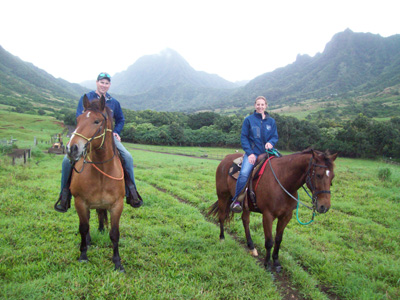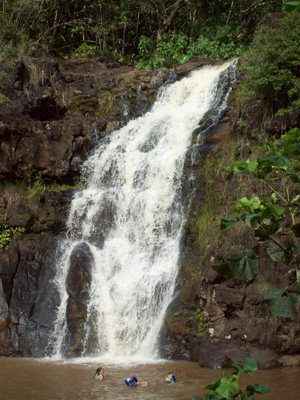 It was the vacation of a lifetime- two weeks in Hawai’i.
It was the vacation of a lifetime- two weeks in Hawai’i.
Close friends moved to the island of O’ahu and invited us to visit. They graciously opened their home to us, making it an offer we couldn’t resist.
We landed in Honolulu, the state capital, located on O’ahu, the state’s third largest island. The diamond shaped island, nicknamed, “The Gathering Place”, held the promise of adventure and relaxation.
Eager to explore the island we didn’t waste a minute planning excursions to the Dole Pineapple plantation, Pearl Harbor, Kaneohe State Park, Diamond Head Crater, beach time on the North Shore, shopping in Historic Haleiwa and even a two-day trip to the remote island of Molokai’i.
With hardly a moment to spare, we knew a trail ride on one of the island’s ranches was a priority. Surprisingly, there were a number of places that offered trail rides- some on the beach, others among the island’s steep sea cliffs and still others that trekked deep into the heart of the island’s valleys.
 We chose Kualoa Ranch, a 4,000 acre tourist destination, working ranch, popular Hollywood film site and ancient historical site. Owned and operated by sixth generation family members, Kualoa Ranch welcomes visitors from all over the world.
We chose Kualoa Ranch, a 4,000 acre tourist destination, working ranch, popular Hollywood film site and ancient historical site. Owned and operated by sixth generation family members, Kualoa Ranch welcomes visitors from all over the world.
The ranch features diverse activities from jungle expeditions, to ATV and horseback rides, to tours of the property’s ancient fish ponds and botanical gardens to full day jaunts to the ranch’s Secret Island among others.
For us, there was no question, it would be the two-hour trail ride. When management learned the ranch would be featured in an article, we were introduced to our private tour guide, Erika Delatorre. Born and raised on the island, Erika had been an employee of the ranch for a number of years. Her knowledge of the ranch’s history and the history of horses on the island provided an education we couldn’t have received elsewhere.
Ancient Hawaiians considered Kualoa one of the most sacred places on the island of Oʻahu. It was the residence of kings, a place of refuge and sanctuary – a puʻuhonua – and a training ground for royalty who were instructed at Kualoa in the arts of war, history and social traditions (www.kualoa.com/about/history).
In 1828, Dr. Gerritt P. Judd traveled from the East Coast to Hawaii as a missionary to become an advisor to King Kamehameha III. In 1850, Judd purchased his first 622 acre Ahpo (land division), that included prime ranch land and all fishing rights. The Ahpo included a small island, named Mokoli’i, also called Chinaman’s hat.
 Later, additional acreage in the Hakipuʻu and Kaʻaʻawa valleys were purchased by Dr. Judd’s son, Charles Hasting Judd. The second purchase increased the total land holdings to 4,000 acres. From 1863 until 1870, the ranch operated as a sugar mill. During this time, the family suffered a great tragedy when Charles’ 7-year-old grandson fell into a vat of boiling sugar water and succumbed to his injuries.
Later, additional acreage in the Hakipuʻu and Kaʻaʻawa valleys were purchased by Dr. Judd’s son, Charles Hasting Judd. The second purchase increased the total land holdings to 4,000 acres. From 1863 until 1870, the ranch operated as a sugar mill. During this time, the family suffered a great tragedy when Charles’ 7-year-old grandson fell into a vat of boiling sugar water and succumbed to his injuries.
“The story goes that Charles had been on the opposite side of the island at the time of the accident and galloped his horse home to be at his grandson’s side,” Erika said. Remains of the sugar mill remain as a memorial to the young boy. Eventually, a shortage of rainfall brought an end to sugar farming on the ranch.
Nearly 75 years later, Kualoa Ranch became a strategic location for the United States Military. “The property was seized by the government during World War II,” Erika explained. The military operated an auxiliary airstrip at Kualoa ranch and used many of the property’s monkeypod trees as natural hangars for the small planes.
Defense posts were built to help defend the island from another attack. “These pillboxes and bunkers were left intact after the land was given back to the family at the end of the war,” she pointed out, “you can even read some of the writings inside.”
For several decades after the war, the ranch served a number of purposes and came to embrace tourism. While catering to visitors, the ranch raises grass fed cattle. The herd numbers close to 600 cows that includes mother cows, bulls, calves and heifers. The Angus, Brangus and Hereford cattle graze 1,500 acres of pasture and bear the Kualoa brand “33.”
That was first used in the late 1800s supposedly because the ranch was the 33rd ranch from downtown Honolulu at the time. Now it is one of a handful of ranches left on the island.
 Like mainland operations, Kualoa Ranch depends on diversity. In addition to raising cattle and providing tourists a destination, the ranch has become a film site for Hollywood producers. Scenes from Jurassic Park, Windtalkers, Pearl Harbor, Godzilla, Tears of the Sun and 50 First Dates have all been filmed on the ranch.
Like mainland operations, Kualoa Ranch depends on diversity. In addition to raising cattle and providing tourists a destination, the ranch has become a film site for Hollywood producers. Scenes from Jurassic Park, Windtalkers, Pearl Harbor, Godzilla, Tears of the Sun and 50 First Dates have all been filmed on the ranch.
Television shows including the old and new Hawaii Five-O, Magnum P.I. and LOST have also been shot on the ranch. At the conclusion of filming, the ranch requests a small part of the set be left behind for tourists to view.
“One of Godzilla’s footprints had been left for people to see,” Erika noted, “but the cattle kept getting into it and were unable to get out on their own so it had to be filled in.”
Above all else, the Morgan family strives to be role model stewards of the ‘āina (land). They are preserving and protecting the land from development and encouraging local school children to learn about caring for the land.
Horses not native to Hawai’i
As we traversed the ranch on horseback, it never occurred to us that horses did not live on the islands until the late 1700s.
Erika explained that cattle and sheep were the first livestock to arrive. George Vancouver, the British captain of the warship Discovery, delivered cattle and sheep to King Kamehameha I as a gift in an effort to strengthen times between England and Hawaii. Many of the cattle in the first delivery died of disease.
In 1794, he brought a second shipment of cattle to the Kona coast. Those cows calved healthy offspring and in honor of the success King Kamehameha I declared a kapu prohibiting the killing of cattle.
 Over the next decade, the cattle multiplied and roamed the islands at will, eventually becoming a nuisance. The wild cattle destroyed taro, banana and papaya crops and terrorized people.
Over the next decade, the cattle multiplied and roamed the islands at will, eventually becoming a nuisance. The wild cattle destroyed taro, banana and papaya crops and terrorized people.
In 1803, Richard Cleveland brought four horses from California to Hawai’i as a gift for the King. At first, the King was unimpressed, but over time, he realized horses could play a significant role developing the islands.
The King was the first Hawaiian to ride a horse, fulfilling an ancient prophesy made by an old sage, Kekiopilo, who said, “White people shall come here; they shall bring dogs with very long ears, and men shall ride upon them.” The Hawaiians called the horses, Li’o, meaning “wild eyed or restless”.
Eventually, the kapu on cattle was lifted and Hawaiians discovered the increasing value in the cow’s hides. They knew they needed a way to catch the cattle without ruining the hides so in 1832, King Kamehameha III invited vaqueros to Hawaii to teach them how to work cattle and horses.
The Hawaiian language has no “s” sound. Hence, the cowboys were called Paniolo, after the word Espanol, meaning Spainard or Spanish. The vaqueros taught the Hawaiians to train their horses, braid ropes and build their own saddles. The Hawaiian paniolos developed a saddle that used very little leather, no nails or tacks and instead used rawhide braiding to secure brass rigging.
 Paniolo hunted and lassoed wild cattle and with the help of their horse, pulled the cattle up tight to a tree and tie the cattle’s horns. After catching their quota for the day, they would go home for the night and return the next morning with a tame steer to help lead the cattle home. This technique eventually became a rodeo event, unique to Hawaii called Po’o Wai U.
Paniolo hunted and lassoed wild cattle and with the help of their horse, pulled the cattle up tight to a tree and tie the cattle’s horns. After catching their quota for the day, they would go home for the night and return the next morning with a tame steer to help lead the cattle home. This technique eventually became a rodeo event, unique to Hawaii called Po’o Wai U.
The end of the trail
Before we knew it, two hours had passed and our ride was over!
We still had questions about the history of the ranch and the horse’s introduction to the islands. However, our time was up, we’d have to seek out more information searching the web or reading books like The Aloha Cowboy co-authored by Virginia Cowan-Smith and Bonnie Domrose Stone, which provided much of the information taught to the ranch hands for use during the rides.



You must be logged in to post a comment Login